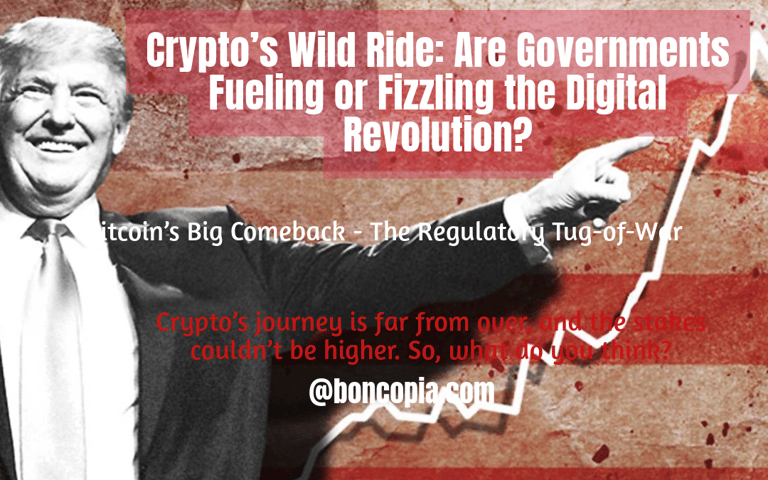Crypto’s Wild Ride: Are Governments Fueling or Fizzling the Digital Revolution?
4/20/2025


Crypto’s Wild Ride: Are Governments Fueling or Fizzling the Digital Revolution?
The crypto world is buzzing. Bitcoin is clawing its way back to glory, decentralized finance (DeFi) is churning out game-changing innovations, and governments worldwide are stepping into the ring with regulations that could make or break this digital frontier. Whether you’re a crypto newbie or a blockchain veteran, one thing’s clear: the future of cryptocurrency hinges on a delicate dance between innovation and control. Let’s dive into the latest trends and unpack how global policies are shaping the crypto landscape.
Bitcoin’s Big Comeback
Bitcoin, the granddaddy of crypto, is staging a fierce resurgence. After weathering brutal bear markets, its price has been climbing in 2025, fueled by institutional adoption and renewed retail enthusiasm. Spot Bitcoin ETFs are drawing in traditional investors, while miners are doubling down on eco-friendly operations to counter environmental critiques. But Bitcoin’s rally isn’t just about numbers—it’s a signal that crypto’s staying power is stronger than ever. The question is: can it sustain this momentum under growing regulatory scrutiny?
DeFi: The Frontier of Finance
While Bitcoin grabs headlines, DeFi is quietly revolutionizing how we interact with money. From decentralized lending platforms to yield farming protocols, DeFi is creating a financial ecosystem free from middlemen. In 2025, breakthroughs like cross-chain interoperability and scalable layer-2 solutions are making DeFi faster and cheaper. Projects like Uniswap and Aave are pushing boundaries, offering users unprecedented control over their assets. Yet, DeFi’s rise isn’t without challenges—governments are eyeing its unregulated nature with suspicion, and that’s where the plot thickens.
The Regulatory Tug-of-War
Governments are no longer sitting on the sidelines. From the U.S. to the EU to China, policymakers are crafting rules to govern crypto’s wild west. The EU’s MiCA (Markets in Crypto-Assets) framework aims to standardize regulations across member states, offering clarity but demanding compliance. In the U.S., the SEC is cracking down on unregistered securities, while the Treasury pushes for stricter anti-money laundering (AML) measures. China, meanwhile, continues its crypto clampdown, banning trading outright.
These moves spark a heated debate: are regulations stifling innovation or paving the way for mass adoption? On one hand, clear rules could legitimize crypto, attracting institutional players and cautious retail investors. The approval of Bitcoin ETFs in multiple countries is a prime example—regulation opened the door to billions in new capital. On the other hand, heavy-handed policies risk smothering the very innovation that makes crypto unique. DeFi, with its decentralized ethos, could face existential threats if governments demand centralized oversight. Small startups, unable to afford compliance costs, might get squeezed out entirely.
The Innovation-Adoption Paradox
The tension between regulation and innovation isn’t just a policy wonk’s problem—it’s the heart of crypto’s future. Too much regulation, and we lose the decentralized dream that birthed blockchain. Too little, and we risk scams, fraud, and market chaos that scare off mainstream users. Some argue that smart regulation—like clear tax guidelines or consumer protections—could bridge the gap, making crypto accessible without killing its soul. Others fear that governments, driven by control or outdated financial systems, will overreach, pushing innovation to unregulated corners of the globe.
Take stablecoins, for example. They’re a gateway for millions to enter crypto, but regulators are nervous about their systemic risks. The U.S. is mulling a stablecoin framework that could either bolster trust or choke off smaller players. Similarly, DeFi’s permissionless nature is a double-edged sword—empowering users but inviting regulatory crackdowns. The outcome of these battles will decide whether crypto becomes a mainstream financial tool or remains a niche rebellion.
What’s Next for Crypto?
As Bitcoin surges, DeFi innovates, and governments tighten their grip, the crypto world stands at a crossroads. The next few years will reveal whether this digital revolution can coexist with traditional systems or if it’s destined for a perpetual tug-of-war. For now, staying informed is key. Platforms covering crypto news, like the one teased in our excerpt, offer a front-row seat to this high-stakes drama.
Crypto’s journey is far from over, and the stakes couldn’t be higher. So, what do you think?
Will regulations ultimately help or hinder crypto’s path to mass adoption?
Can DeFi survive in a world of tightening government oversight?
Is Bitcoin’s resurgence a sign of lasting strength or a fleeting hype cycle?
Let’s keep the conversation going—drop your thoughts below!
Bitcoin’s Big Comeback - The Regulatory Tug-of-War
hello@boncopia.com
+13286036419
© 2025. All rights reserved.